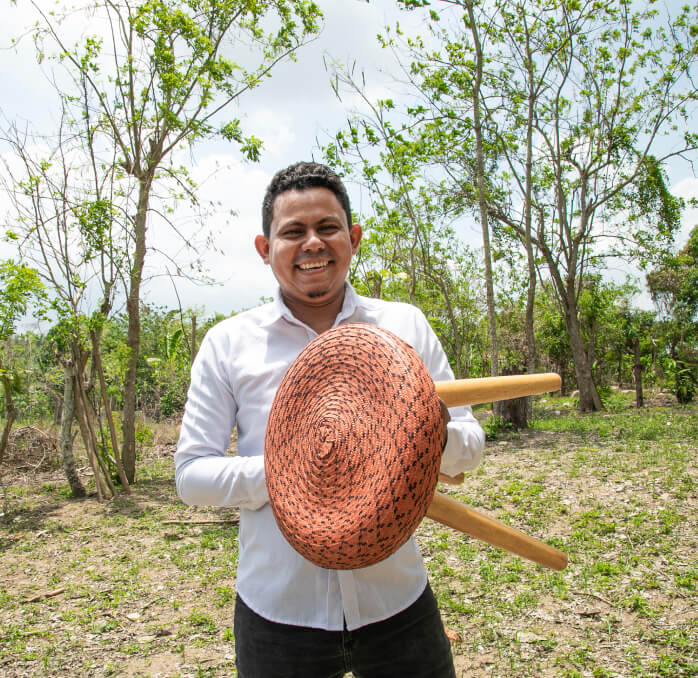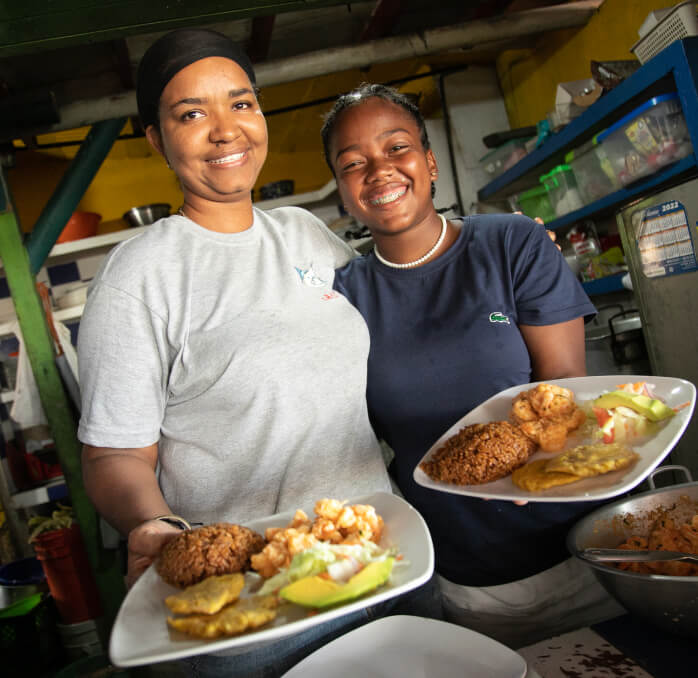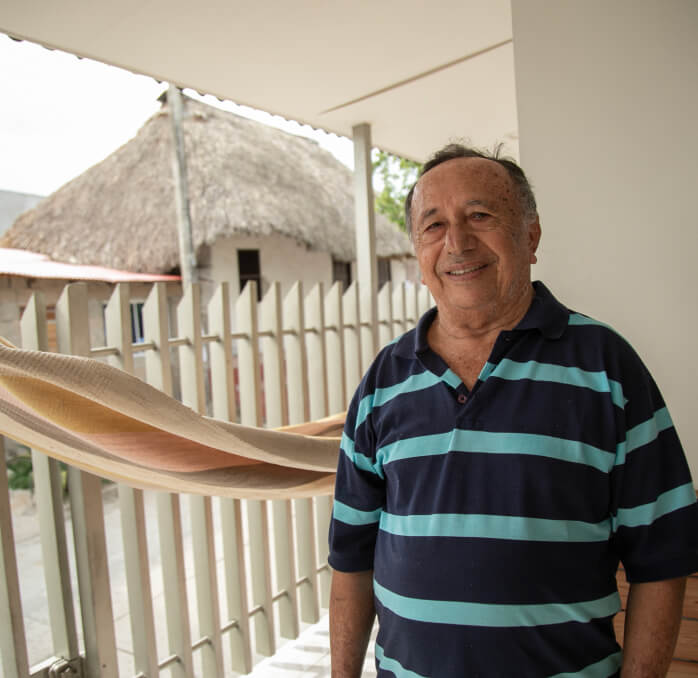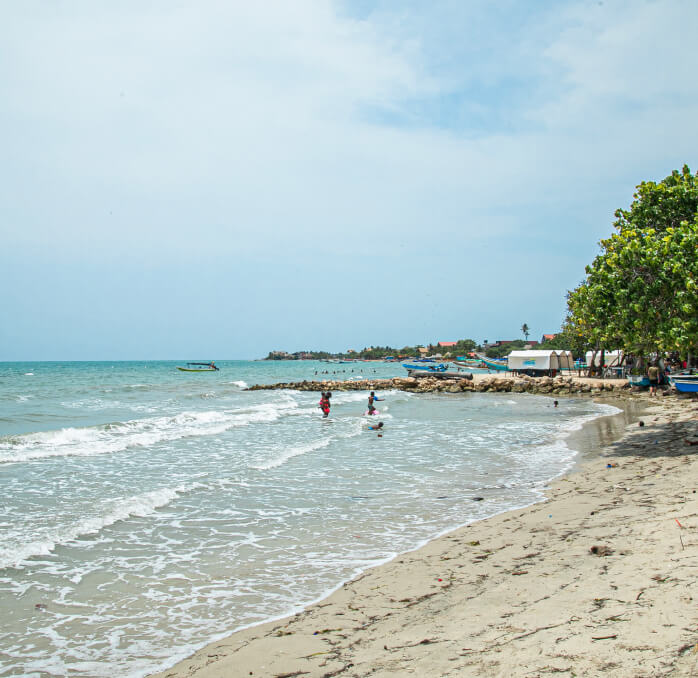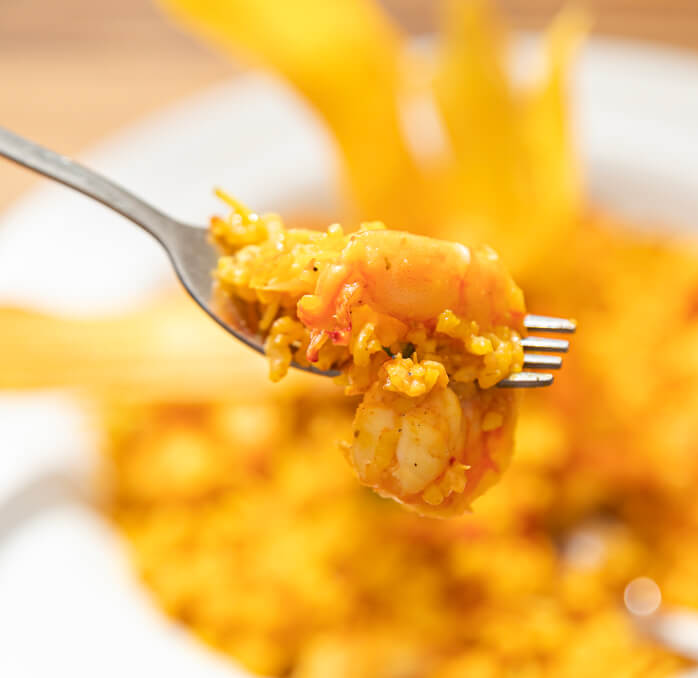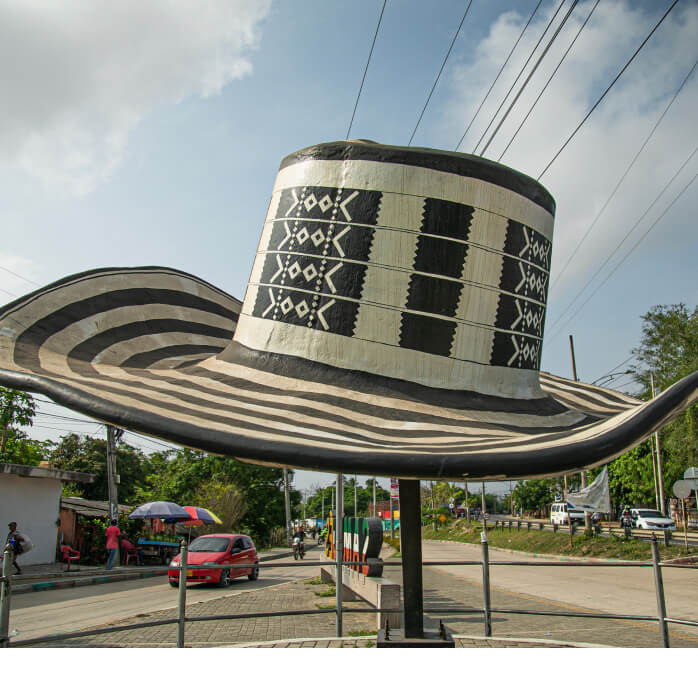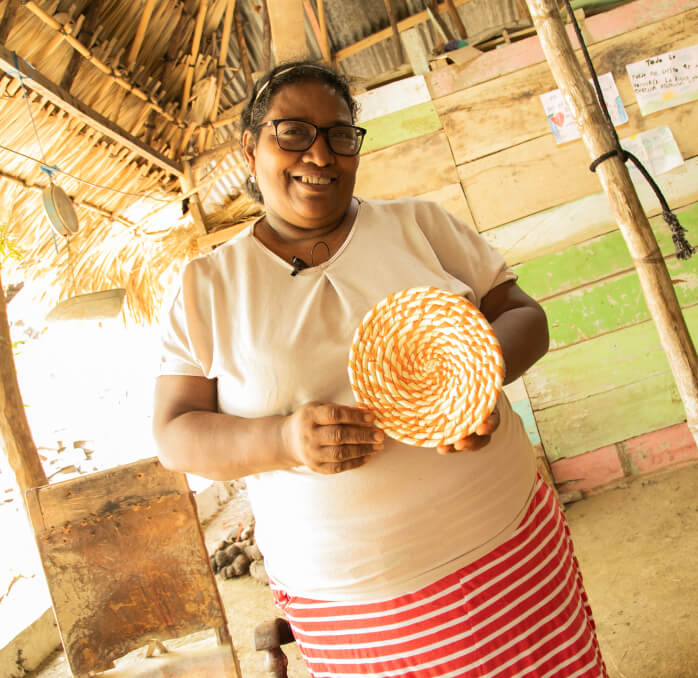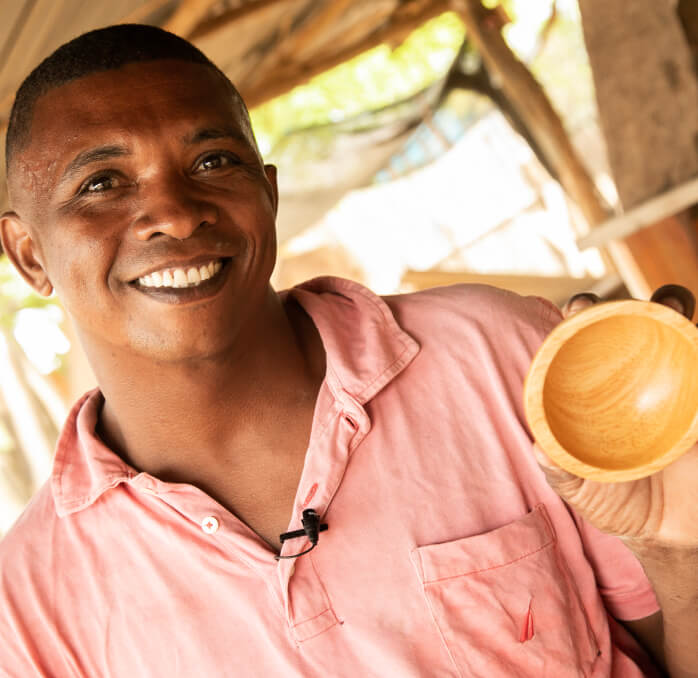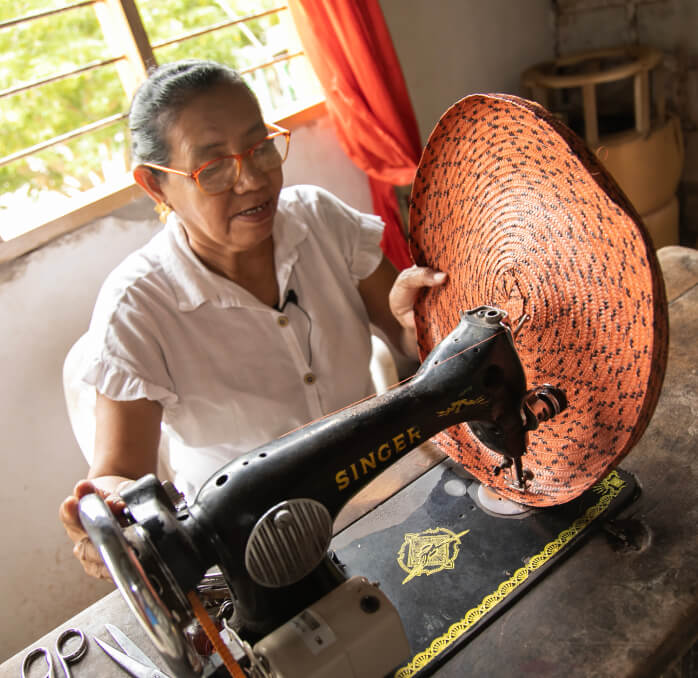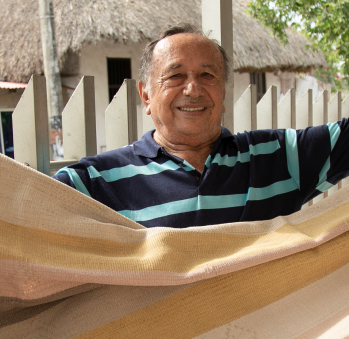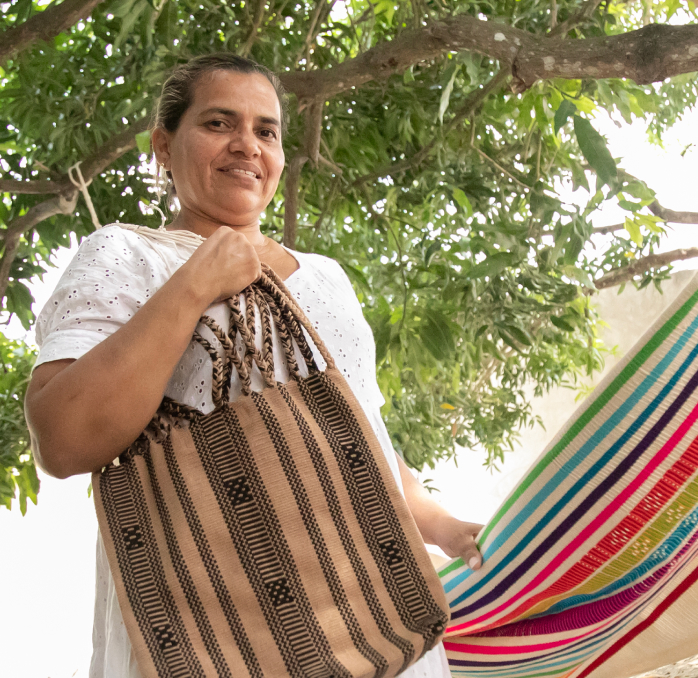Sucre Route
When you visit Sucre and come into contact with its fertile and green savannah, its Montes de María, and its part of the Caribbean Sea, you understand why so many composers of “”porros”” and “”vallenatos,”” including Rubén Darío Salcedo and Alfredo Gutiérrez, have sung about this land. Besides inspiring heartfelt songs, the landscape has also spoken to the artisans of this department, one with a clear artisanal vocation, and inevitably, it has manifested in their creations. It’s not possible to separate the craftsmanship from the place where it’s made, and this becomes evident when the Montes de María or the animals native to the region, such as guartinajas or hicoteas, are represented with fibers and wood. In these rich and warm lands of Morroa, Sampués, San Onofre, and Colosó, caña flecha grows along with palma de iraca, ceiba tolúa, colorado, and cotton—plants used as raw materials for sombrero vueltiaos, iraca baskets, carved wooden pieces, and woven hammocks.
We propose a route where you’ll discover how the artisans on our map transform what the land provides into unique objects, all while enjoying the landscape of savannah and sea, music, and traditional dishes in the company of the warm and friendly locals who make all visitors feel welcome. You’ll witness the coexistence of the Zenú ethnic heritage and Christian traditions in their devout towns, known for their Holy Week celebrations. You can’t leave without having a corozo juice and tasting the delicious mote de queso or mote de guandul, along with local treats like bollo limpio, diabolines, and pasteles de la sabana. Plan your visit to coincide with the department’s festivities: the Tolú Sailboats Encounter in March, the religious processions of Tolú during Holy Week, the Pito Atravesao Festival in Morroa at the beginning of June, the National Band Encounter in Sincelejo in November, or the National Sombrero Vueltiao Beauty Pageant in Sampués at the end of the year.
Embark on a journey full of history

Artisans along the way
Artisans along the way
We recommended this tour
Schedule the visit in advance with the artisans
Carry cash
3 days
Car or Bus

MORROA — SAMPUÉS — TOLÚ
We begin the route in a picturesque village of hammock weavers. If you arrive at Las Brujas Airport in Corozal it’ll take you 15 minutes (4.6 km) to arrive in Morroa. Monuments like La Devanadora sitting on her stool and El Pitero Pablo Domínguez, which celebrate thread weaving and the pito atravesao, a cane flute played like a transverse flute, will welcome you. You’ll understand why this is a land of weavers, as it’s customary for the people of Morroa to sit on their terraces and practice their craft. We invite you to meet Minelva Corena and Argemiro Corrales, who will show you every step of the weaving process, from winding the thread to weaving the fabric. With Argemiro, you’ll also learn about his marvelous work with natural dyes. Climb the dome of the San Blas church for a view of the undulating terrain of the Montes de María and try the pasteles de la sabana from the Piña sisters by the road, which, as the story goes, were a must-stop for Diomedes Díaz. You cannot leave without trying an amasijo with pava de ají dressing.
Sampués, an old Zenú indigenous reservation, is 26 kilometers away from Morroa. We recommend you to have a Sucre-style barbecue or a sancocho for lunch at the restaurant La Becerra. For dessert, head to the park and try the Helados Coquitos. In Sampués, visit Élida Polo and her son Víctor Otero, who will show you everything that can be crafted with the caña flecha braids used to weave the traditional sombrero vueltiao. Eleven kilometers from the town is the indigenous community of Huertas Chica, where the Zenú Ecotourism Park was inaugurated. This place allows you to learn more about their culture and history while enjoying nature by a beautiful lagoon.
Before heading to Tolú, which is 53 kilometers away and where we recommend you to spend the night, enjoy the typical bollos casaos and ask for a taste of the corn chicha distilled in the process.
TOLÚ — SAN ONOFRE
You can’t come to Sucre without spending at least two days on the white sandy beaches and crystal-clear waters of Tolú. Here, the swamp, mangroves, beaches, and reefs surrounding the San Bernardo islands in the Gulf of Morrosquillo come together. If you’re into ecotourism, you can support community-based tourism and mangrove conservation at Ciénaga de la Leche natural reserve, a 20-minute drive from the urban area. You can also engage in birdwatching in La Loma.
Choose one of the two days to take an early boat to the San Bernardo archipelago. Its white beaches surrounded by coral reefs await you, for relaxing in the sun or diving. But if you don’t feel like moving, you can sunbathe on El Francés Beach or the Tolú boardwalk, where you’ll find a wide range of restaurants offering delicious seafood stews or a sierra, red snapper, chipi chipi, shrimp, or lobster. Visit the House of Culture and the Gastronomic and Touristic School of the Gulf of Morrosquillo.
San Onofre is 35 kilometers away from Tolú. Here lives Blas Agustín Blanco, a carver of ceiba tolúa, colorado, and teca wood, who skillfully transforms the material into vessels and animal figurines. After learning about his work and on your way to Rincón del Mar, a beach area, pass by the El Higuerón village to visit Carmelo Castillo, a wood artisan who handcrafts vessels inspired by the surrounding nature, and has the right words to describe the deep love he feels for his craft. We recommend spending the night here and having lunch at the restaurant La Negra. If you want to continue exploring the Caribbean coast, choose between Verrugas or Balsillas beaches or the mangroves of the Sanguaré Natural Reserve.
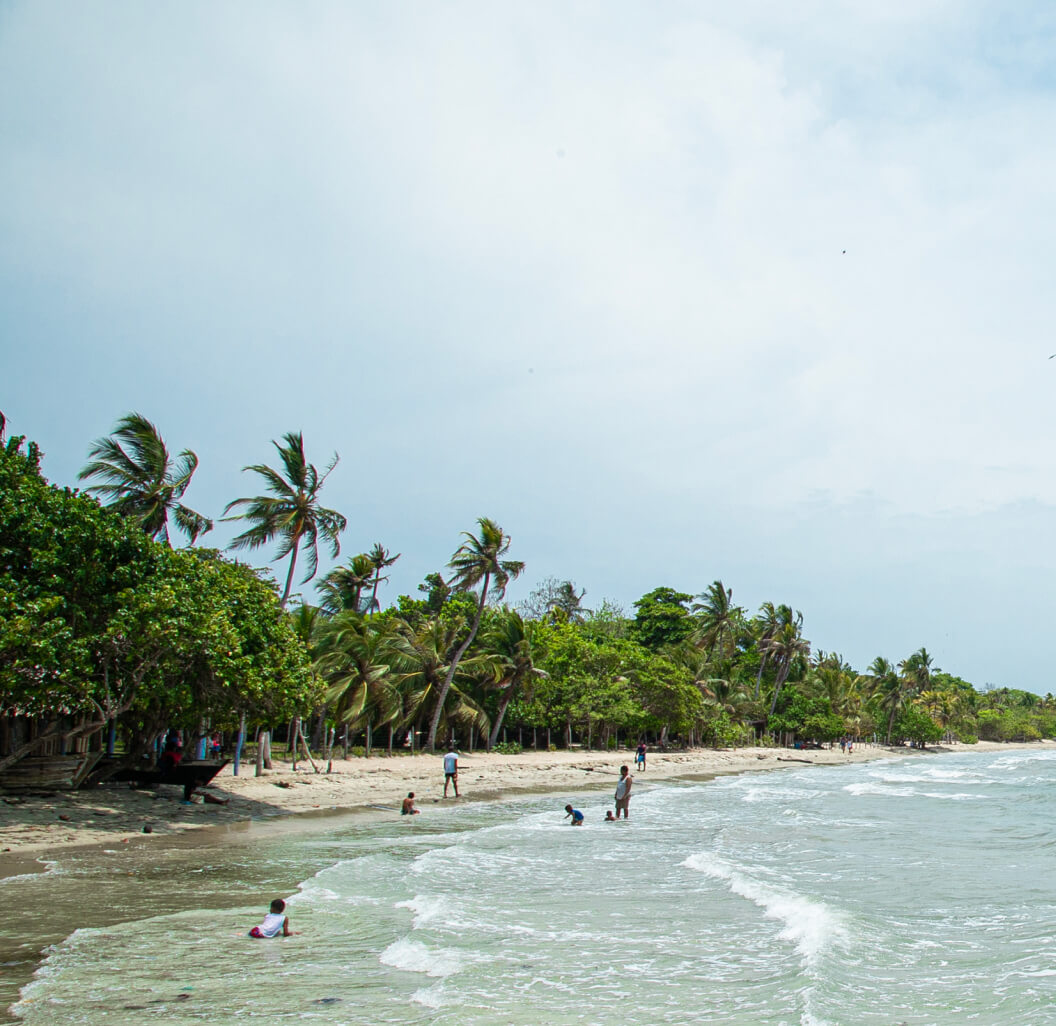
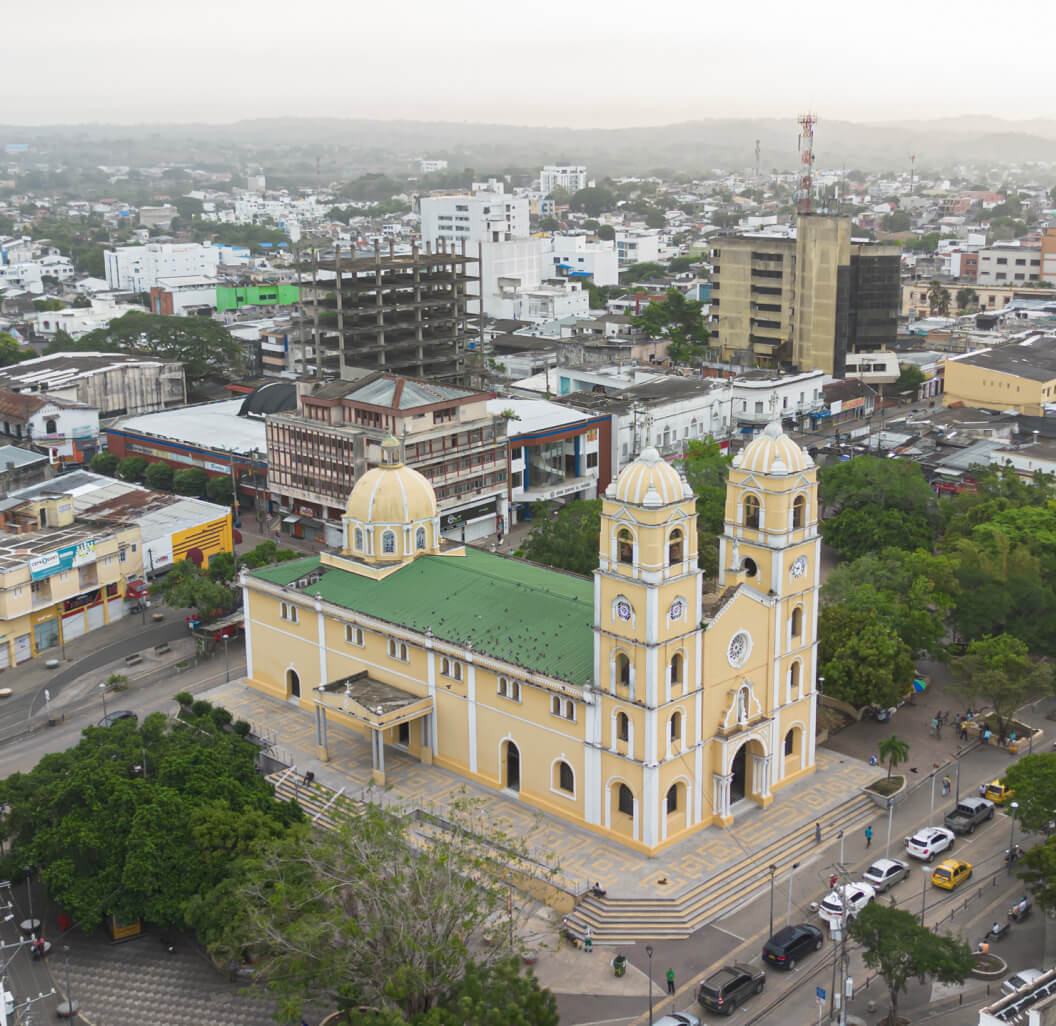
COLOSÓ — SINCELEJO
We return from the sea to the Montes de María to visit Colosó, 65 kilometers away from San Onofre. This town seems like something out of a fairy tale. Among its colonial architecture and wooden structures, the Church of San Miguel Arcángel, the Public Library, and the House of Culture stand out. Near the town, you can refresh yourself in the clear and fresh waters of Salto del Sereno or Pozo de Arizal, where iraca palms grow wild on its banks, a plant used by the artisans of Martha Borja’s workshop in Colosó. This kind and ingenious woman leads a group of over 20 weavers who use the iraca coils technique, which was invented right here. Depicted in their baskets, you can see the rich surrounding nature, the fruits from their garden, and the visiting birds.
We finish the route 34.6 kilometers away in the capital, Sincelejo, famous for its bull festivals held in January. You’ve likely heard the porro music Fiesta en Corralejas, which has been playing since 1969 and still sets the tone for Christmas and New Year’s celebrations. If so, when you visit Plaza Majagual, a daily meeting point for the people of Sincelejo, ask for Rubén Darío Salcedo, its composer, who usually spends the afternoon there. Next to the square is the Finzenú Museum, where you can learn more about their history and cultural legacy. Then, walk to Parque Santander, where the Departmental Band performs porros from the savannah every Wednesday. Visit the impressive Cathedral of San Francisco de Asís and the Olaya Herrera Plaza. Before saying goodbye, we recommend having lunch at Gastrolab, very close to Plaza Majagual, and trying their unique twists on typical regional ingredients. Alternatively, try María Bonita in the city center to enjoy a hearty mote de queso or sancocho that will certainly leave you pleased and eager to return.
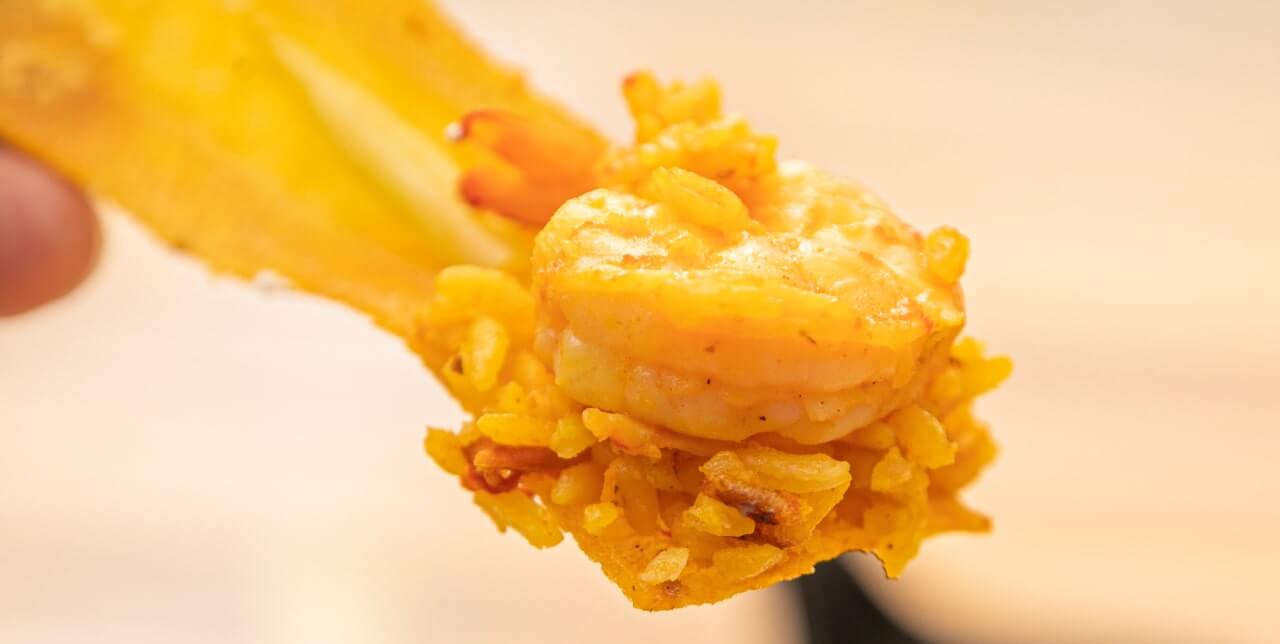
Traditional cuisine
and typical bites
Provoke yourself
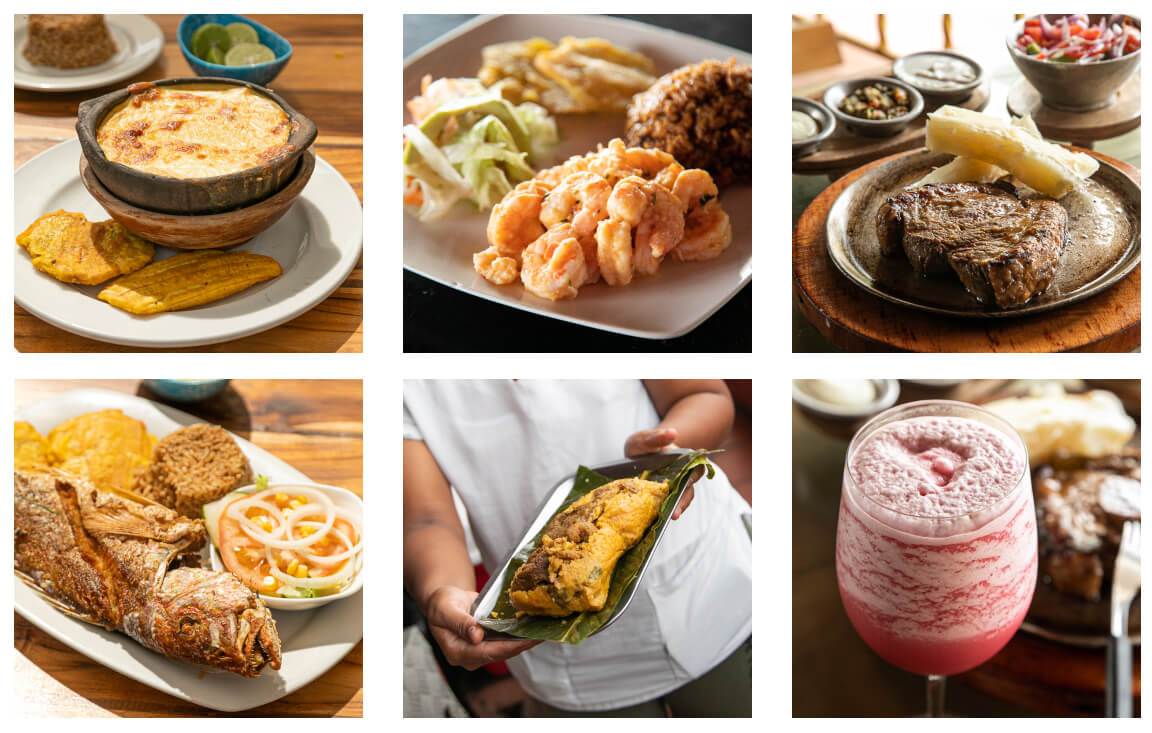
Don't leave without eating this 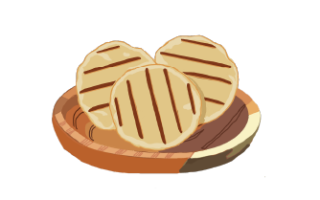
El Golfo de Morrosquillo nos ofrece gran variedad de pescados y frutos del mar de la pesca del día preparados de diferentes formas y que nos permiten conocer la cultura de esta parte del departamento; pescados y mariscos fritos, sudados y asados, acompañados de arroz con coco y ñame. Los restaurantes Montucuy, en Coveñas, y Tolú al día son opciones recomendadas para probarlos.
El mote con queso y bleo, acompañado de arroz de cabecita negra es el plato de mayor representatividad y originalidad en el departamento. Es una poderosa sopa de ñame, queso costeño, suero y el bleo de chupa, una planta de hojas comestibles, que le da una distinción especial. El arroz de cabecita negra es un acompañamiento imprescindible de los diferentes platos del departamento. Para probar este delicioso plato en la ciudad de Sincelejo ve al restaurante Rancho Grande.
To lunch we go 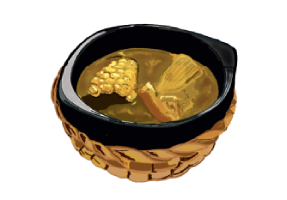
El viudo de pescado elaborado con Bocachico, y diferentes pescados de río, es una preparación que reúne los sabores fluviales del departamento. Es un guisado de pescado que se acompaña de ñame, yuca y plátano, todos estos cocinados encima del pescado para captar toda su sazón. En los restaurantes Itamburí, en Tolú, y Miro mar, en la vía a San Onofre, puedes probarlos con todas las de la ley.
El mondongo, preparación insignia de Sucre, es una sopa cocinada por largas horas, con la panza de la vaca, pata de res, ñame, plátano, guiso y especias. En el restaurante Donde Mingo, en Galeras, se ofrecen variedad de platos típicos para turistas y locales.
Flavors to discover and snack on 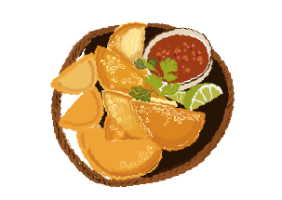
Sucre ofrece a sus comensales preparaciones autóctonas que varían de acuerdo a la ubicación geográfica. Prueba en Diabolines La Favorita en Sincelejo estas bolitas crujientes de masa de yuca y queso costeño, acompañados de jugo de corozo o chicha. También los pasteles de la sabana son envueltos elaborados con masa de maíz y carnes adobadas, entre hojas de plátano y cocidos al vapor; para disfrutar de ellos está el restaurante Pasteles de la Sabana, en Corozal. Hacia la costa prueba la variedad de ceviches y crudos de la pesca del día, que se acompañan del bollo limpio, una preparación de maíz que se cuece envuelta en hoja de bijao o plátano y es un acompañamiento obligado para la mayoría de platos del departamento. La Cevichería y Restaurante Roberto, en Tolú es una buena opción para comerlos.
To sweeten the palate and unmissable drinks 
Aquí las preparaciones de dulces a base de fruta, como los caballitos de papaya verde, conservados en almíbar de panela, la jalea de mango, el arroz con leche o el con coco, dulce hecho en leche de coco y canela, las cocadas, el dulce de ñame y la torta de ahuyama se convierten en el final perfecto de la merienda de la tarde y un paso obligado por las plazas de mercado del departamento. Existen emprendimientos locales como Wen frutas naturales, en Sampués, que ofrecen estas delicias dulces y sus conservas de frutas para que turistas y locales puedan llevar a sus hogares y disfrutarlas a cualquier hora.
En Sucre existen una gran variedad de bebidas fermentadas como la chicha de maíz, de corozo, de arroz y de tamarindo, deliciosos jugos de corozo, zapote, mango biche y maduro y el guarapo de papelón con jugo de limón que, bien frío, refresca tremendo calor. Estas bebidas es muy común encontrarlas en las plazas de mercado y los diferentes parques de los municipios.
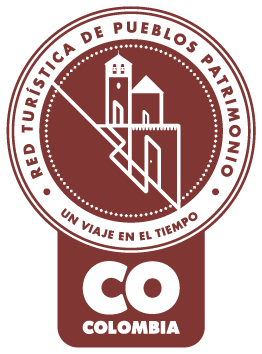
Pueblo Patrimonio
La Red Turística de Pueblos Patrimonio de Colombia es un programa especial del Ministerio de Comercio, Industria y Turismo, ejecutado por FONTUR, que trabaja con 17 municipios de Colombia que poseen declaratoria de Bien de Interés Cultural (BIC) a nivel nacional para su valoración y proyección mediante el turismo, generando así más oportunidades de desarrollo y sostenibilidad en las comunidades.

La Medalla a la Maestría Artesanal es un galardón que Artesanías de Colombia entrega anualmente, con el cual se hace un reconocimiento a aquellos artesanos, empresas y comunidades artesanales que, contando con una trayectoria destacada, sobresalen a nivel nacional por su excelencia en el oficio así como por preservar el quehacer artesanal.

Denominación de Origen
Es un signo distintivo que identifica productos reconocidos o famosos por tener una calidad o características específicas derivadas esencialmente del lugar de origen y la forma tradicional de extracción, elaboración y producción por parte de sus habitantes. La protección conferida sobre una Denominación de Origen implica que ninguna persona puede identificar con la denominación protegida productos iguales o similares a los amparados, cuando no provengan del verdadero lugar y no cumplan con las características o calidades que le han dado la reputación al producto reconocido. Las Denominaciones de Origen para productos artesanales colombianos que han sido protegidas por la Superintendencia de Industria y Comercio en nuestro país son actualmente 12.
No puede copiar contenido de esta página









































